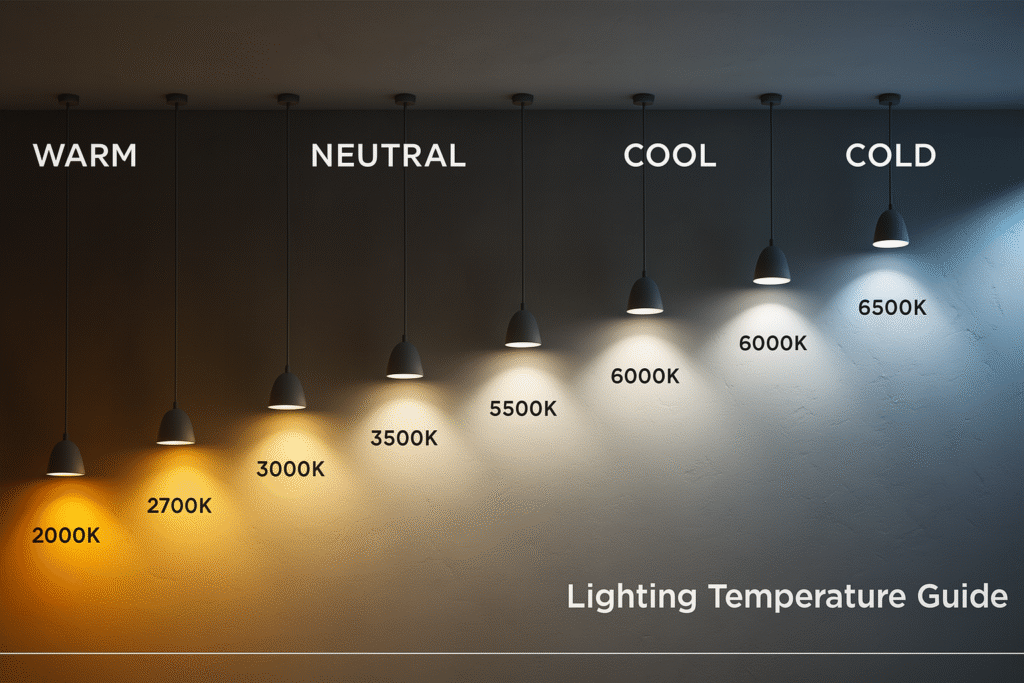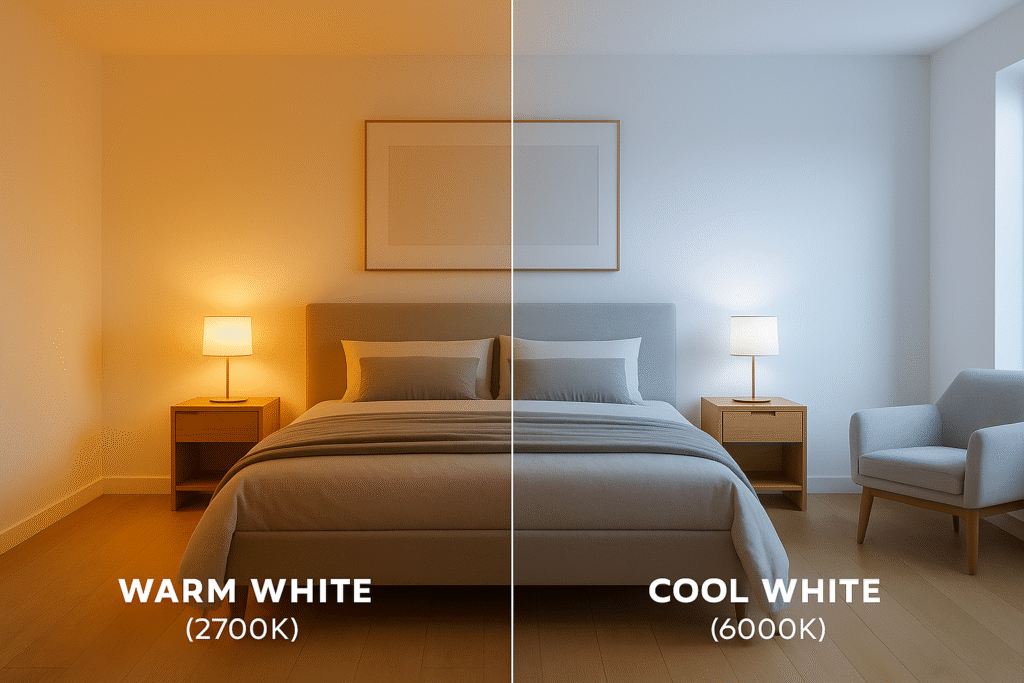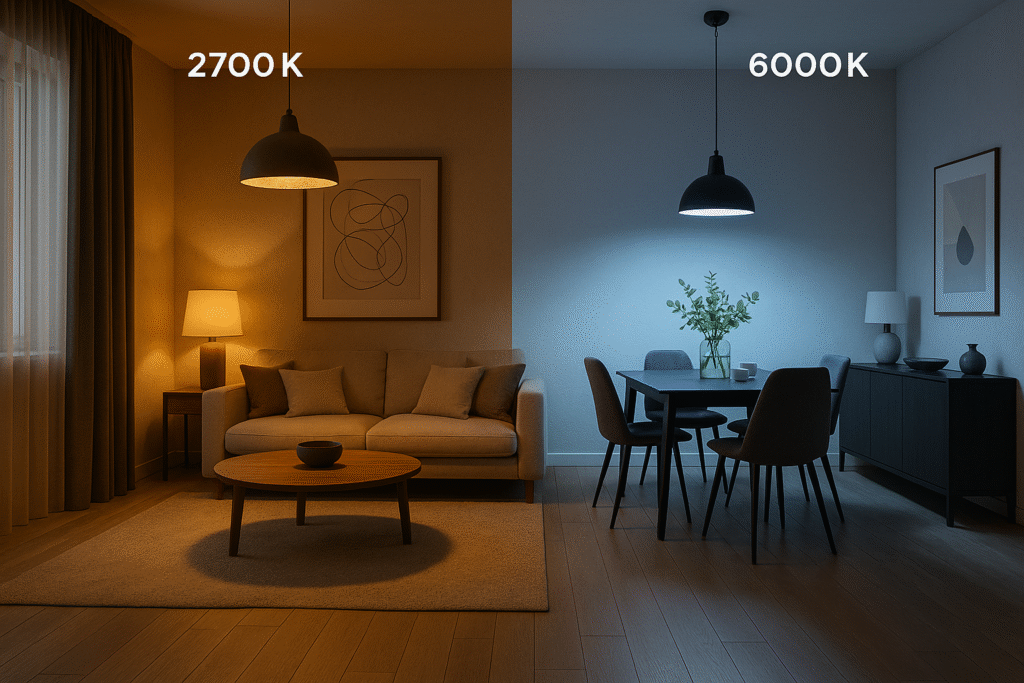How to choose the correct lighting, colour temperature for your home?
Lighting is more than just a way to brighten a room — it shapes how a space feels and functions. In a city like Dubai, where many rooms rely on artificial light, choosing the right lighting colour can make a big difference in comfort and practicality.
One important detail to understand is lighting temperature, which refers to the colour or tone of the light — not how hot the bulb gets. It’s measured in Kelvin (K) and ranges from soft yellow light to bright white or even bluish tones.
Kelvin (K)
Appearance
Typical use
< 2700K
2700K – 3000K
3500K – 4100K
5000K – 6500K
> 6500K
Very Warm / Amber
Warm White
Neutral / Cool White
Daylight / Bluish White
Daylight / Bluish White
Restaurants, vintage lighting
Living rooms, bedrooms,
Offices, kitchens, retail stores
Task lighting, hospitals, outdoor
Specialised applications, industrial
What is lighting temperature?

Lighting temperature is measured on a Kelvin scale. Lower numbers (like 2700K) give off warm, yellowish light. Higher numbers (like 6000K) produce cooler, bluish-white light.
Temperature
Light type
How it looks
2000K–3000K
3500K–4500K
5000K–6500K
7000K+
2000K–3000K
3500K–4500K
5000K–6500K
7000K+
2000K–3000K
3500K–4500K
5000K–6500K
7000K+
Different types of lighting are better suited to different rooms, depending on how you use the space.
Choosing the correct light / colour for each room

Living rooms & bedrooms – 2700K–3000K
- Feels warm and cozy
- Good for relaxing and evening use
- Works well with wood furniture and soft fabrics
Kitchens & bathrooms – 4000K–4500K
- Gives a clean, clear look
- Bright enough for tasks like cooking and grooming
- Doesn’t add unwanted yellow or blue tones
Home offices & study areas – 5000K–6000K
- Helps with focus and concentration
- Similar to daylight — good for reading or computer work
- Useful in rooms without much natural light
Shops, display areas, workspaces – 5000K–6500K+
- Makes colours and details stand out
- Used in places like showrooms and retail stores
- Keeps the space feeling active and alert
Here are some things to consider before choosing a light colour
Natural light in the room
Many Dubai homes get limited daylight — especially in apartments or shaded villas. A brighter or cooler light can help balance this.
Wall colours and materials
Light reflects differently off shiny tiles, dark paint, or glossy cabinets. Warm light works well with beige and gold; cool light suits white or grey finishes.
Ceiling height and lighting placement
Think about how the light spreads — pendant lights, spotlights, or indirect lighting all affect how the colour appears.
Smart or adjustable lighting
If you’re using smart bulbs for dimmers, you can adjust the lighting tone depending on time of day or activity.
These are mistakes you need to avoid

- Using cold or blue-toned light in relaxing spaces like bedrooms.
- Mixing different light tones in one open-plan area.
- Choosing very bright or cool lights in rooms with warm-coloured decor.
Room and colour/temperature matching
Room
Temperature range
Why it works
Bedrooms
Kitchen
Home office
Living room
Bathrooms
Retail/display
2700K–3000K
4000K–4500K
5000K–6000K
2700K–3500K
4000K–4500K
5000K–6500K
Calm, soft lighting for rest
Clear lighting for daily tasks
Improves focus and energy
Comfortable and welcoming light
Bright, natural for visibility
Sharp light and color clarity
Final thoughts
Choosing the correct light colour / temperature is about more than looks — it affects how each room works and how you feel in it. Think about what each space is used for, how much daylight it gets, and how the colours in the room will react to the lighting.
A well-chosen light can make a home feel more comfortable, a kitchen more practical, or an office easier to focus in — all without changing anything else in the room.
One other thing to consider which is often overlooked is the placement of specific lighting, this could be for ceiling lights, wall lights, under cupboard lights, floor lighting, security lighting etc.
If lighting is positioned incorrectly it can sometimes cause shadows, or provide poor quality lighting in key areas where it’s needed most.
Lighting is one of the most important factors to consider for any project, renovation as it can completely transform any indoor or outdoor space into something luxurious, modern and often calming. It is down to personal choice of course and there are no set rules – it is your home, so it is entirely your decision.
If you have any questions regarding lighting for your project – if it’s for inside your home, the exterior of the property, your garden / landscaping or if it’s a commercial space then please get in touch. I would be happy to help with any questions you may have.
FAQ'S
What does “Kelvin” mean in lighting?
Kelvin (K) is a unit used to measure the colour temperature of light. Lower values (like 2700K) mean the light is warm and yellowish. Higher values (like 6000K) mean the light is cooler and more blue-white.
Which lighting temperature is best for homes in Dubai?
For most homes in Dubai:
- 2700K–3000K is ideal for bedrooms and living rooms
- 4000K–4500K works well for kitchens and bathrooms
- 5000K+ is suited for task areas like offices or display spaces.
The choice depends on room function, interior finishes, and how much daylight the space receives.
Can I mix different lighting colours / temperatures in my home?
Yes — but only if each zone or room is visually separated. For example, it’s fine to use warm lighting in a bedroom and neutral lighting in the kitchen. But in open-plan areas, mixing warm and cool tones can feel unbalanced and visually jarring.
Does lighting temperature affect mood or productivity?
Yes.
- Warm lighting (2700K–3000K) tends to be relaxing — ideal for rest areas.
- Cool lighting (5000K–6000K) promotes alertness and focus — great for work zones.
Choosing the right lighting can support your daily routine, especially in a climate like Dubai where rooms may not get natural daylight all day.
Can smart bulbs change lighting temperature?
Many smart LED bulbs allow you to adjust the colour temperature — from warm to cool — using an app or voice control. This is useful for multifunctional rooms, like bedrooms that double as home offices or living areas used both day and night.
Is cooler light always brighter than warm light?
Not necessarily. Brightness is measured in lumens, while temperature is measured in Kelvin. However, cooler light often feels brighter because of how our eyes perceive blue-toned light, especially in white or grey spaces.
Copyright © 2025 Vanquish Renovations


